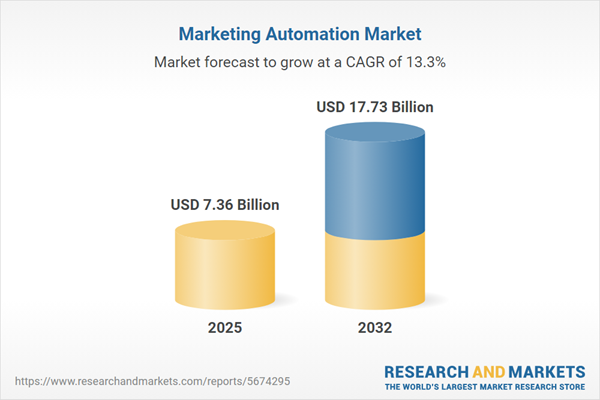Speak directly to the analyst to clarify any post sales queries you may have.
Marketing automation stands at the intersection of technology and customer-centric strategy, reshaping how enterprises orchestrate campaigns, engage audiences, and drive business outcomes. With evolving digital demands, marketing leaders are prioritizing integrated solutions that deliver both operational efficiency and measurable impact.
Market Snapshot: Marketing Automation Market Size and Growth
The marketing automation market grew from USD 6.53 billion in 2024 to USD 7.36 billion in 2025 and is expected to continue expanding at a CAGR of 13.28%, reaching USD 17.73 billion by 2032. This sustained growth is driven by rapidly increasing adoption across diverse industries, rising demand for data-driven personalization, and advancements in AI and machine learning that are boosting automation capabilities at scale for enterprises.
Scope & Segmentation
This report delivers comprehensive analysis and forecasts, covering the following market dimensions to ensure deep and actionable insight:
- Solution Type: Managed Services, Professional Services, Cloud-Based, On-Premises
- Application: Customer Relationship Management (CRM), Automated Campaigns, Personalized Emails, Lead Generation, Lead Nurturing, Lead Scoring, Discount Management, Dynamic Pricing, Analytics & Insights, Content Scheduling
- Organization Size: Large Enterprises, Small & Medium Enterprises (SMEs)
- End-Use Industry: Automotive, Banking, Financial Services & Insurance (Corporate Banking, Retail Banking, Wealth Management), Education, Healthcare (Biotechnology, Hospitals, Pharmaceuticals), IT & Telecommunications (Cloud Services, Network Management, Software Development Tools), Media & Entertainment, Real Estate, Retail, Travel & Hospitality
- Region: Americas (United States, Canada, Mexico, Brazil, Argentina, Chile, Colombia, Peru), Europe, Middle East & Africa (United Kingdom, Germany, France, Russia, Italy, Spain, Netherlands, Sweden, Poland, Switzerland, United Arab Emirates, Saudi Arabia, Qatar, Turkey, Israel, South Africa, Nigeria, Egypt, Kenya), Asia-Pacific (China, India, Japan, Australia, South Korea, Indonesia, Thailand, Malaysia, Singapore, Taiwan)
- Companies Covered: ActiveCampaign LLC, HubSpot Inc., Adobe Inc., Banzai International Inc, Braze Inc., Cisco Systems Inc., ClickDimensions LLC, Damco Solutions, EngageBay Inc., GetResponse S.A., Google LLC by Alphabet Inc., Infusion Software Inc., International Business Machines Corporation, LeadSquared Service, Mailchimp by Intuit Inc., Maropost Inc., Microsoft Corporation, NEC Corporation, Omnisend LLC, Oracle Corporation, Salesforce Inc., SAP SE, SAS Institute Inc., Sendinblue Inc., Teradata Operations Inc., Thryv Holdings Inc.
Key Takeaways: Strategic Insights for Decision-Makers
- Marketing automation is shifting from isolated campaign management to full-scale orchestration of cross-channel workflows, aligning teams and standardizing operational processes.
- Artificial intelligence and analytics power contextual customer engagement, enabling segmentation based on behavioral insights and supporting rapid adaptation of campaign tactics.
- Integrating marketing automation with CRM and customer data platforms allows organizations to centralize insights, improve lead management, and ensure consistent experiences across touchpoints.
- Hyper-personalization is now essential for sustained competitive advantage. Flexible deployment options, from managed services to on-premises solutions, offer compliance and integration for regulated or global enterprises.
- Regulatory pressures and growing data privacy expectations have strengthened demand for consent management, encryption, and real-time compliance reporting within automation platforms.
- Partnering with solution providers, creative agencies, and systems integrators amplifies value, supporting seamless digital transformation and measurable ROI.
Tariff Impact: Navigating Cost Pressures and Supply Chain Shifts
The introduction of new United States tariffs in 2025 significantly altered the marketing automation marketplace by raising costs for software licenses, cloud infrastructure, and professional services. Organizations responded by prioritizing domestic and regionally hosted solutions, renegotiating service agreements, and leveraging modular, containerized deployments to maintain both scalability and compliance. Vendors adapted quickly, offering flexible delivery models and supporting customers' supply chain resiliency amid regulatory change.
Methodology & Data Sources
The findings leverage extensive primary interviews with marketing executives, solution architects, and service partners, complemented by rigorous secondary analysis of industry reports, regulatory filings, and academic publications. Quantitative models and sensitivity analyses underpin all forecasts, validated through peer review and stakeholder feedback.
Why This Report Matters
- Enables senior decision-makers to benchmark their automation strategies against evolving market trends and regulatory shifts.
- Equips organizations with actionable guidance for technology adoption, resource allocation, and partnership selection tailored to sector and regional needs.
- Supports readiness for digital transformation by highlighting the essential roles of AI, integration, and data privacy in driving future market leadership.
Conclusion
Marketing automation’s influence continues to expand as enterprises pursue integrated, customer-centric operations. Agile implementation, robust partnerships, and continuous upskilling are essential for unlocking the full value of automated technologies in a complex market landscape.
Additional Product Information:
- Purchase of this report includes 1 year online access with quarterly updates.
- This report can be updated on request. Please contact our Customer Experience team using the Ask a Question widget on our website.
Table of Contents
3. Executive Summary
4. Market Overview
7. Cumulative Impact of Artificial Intelligence 2025
Companies Mentioned
The companies profiled in this Marketing Automation market report include:- ActiveCampaign, LLC
- HubSpot, Inc.
- Adobe Inc.
- Banzai International Inc
- Braze, Inc.
- Cisco Systems, Inc.
- ClickDimensions LLC
- Damco Solutions
- EngageBay Inc.
- GetResponse S.A.
- Google LLC by Alphabet Inc.
- Infusion Software, Inc.
- International Business Machines Corporation
- LeadSquared Service
- Mailchimp by Intuit Inc.
- Maropost Inc.
- Microsoft Corporation
- NEC Corporation
- Omnisend, LLC
- Oracle Corporation
- Salesforce, Inc.
- SAP SE
- SAS Institute Inc.
- Sendinblue, Inc.
- Teradata Operations, Inc.
- Thryv Holdings, Inc.
Table Information
| Report Attribute | Details |
|---|---|
| No. of Pages | 184 |
| Published | November 2025 |
| Forecast Period | 2025 - 2032 |
| Estimated Market Value ( USD | $ 7.36 Billion |
| Forecasted Market Value ( USD | $ 17.73 Billion |
| Compound Annual Growth Rate | 13.2% |
| Regions Covered | Global |
| No. of Companies Mentioned | 27 |









